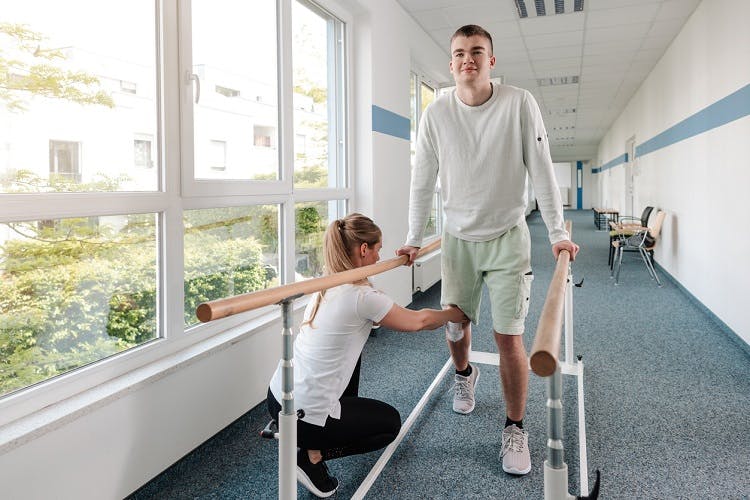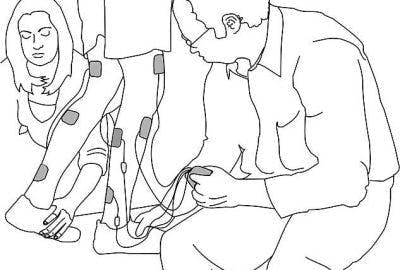No products in the cart.
No products in the cart.
No products in the cart.
No products in the cart.
Home » Neurological Recovery Blog » Spinal Cord Injury » Understanding Muscle Atrophy After Spinal Cord Injury: How to Regain Strength
Last updated on September 16, 2020

Muscle atrophy refers to the shrinking of muscles. This condition is common after spinal cord injuries because damage to the nerves can affect control over the muscles.
The body is extremely adaptive and designed to work as efficiently as possible. Everyday movements like standing, walking, and lifting objects are generally enough to maintain normal muscle mass.
However, in cases like spinal cord injury where movement can be significantly limited, the muscles shrink to conserve energy.
This article will guide you through the types, associated risks, and treatments for muscle atrophy in spinal cord injury patients.
Two types of muscle atrophy can result from a spinal cord injury: denervation atrophy and disuse atrophy.
Denervation atrophy describes when a nerve is damaged and can no longer trigger muscle contractions. This type of muscle atrophy is more common amongst complete or severe spinal cord injury patients who cannot voluntarily contract their muscles.
In contrast, disuse atrophy describes the shrinking of muscles caused by lack of movement. This type of muscle atrophy is more common amongst incomplete spinal cord injury patients who can still control some of their movements but for whatever reasons (depression, pain, etc.), become much less active.
Fortunately for individuals with disuse atrophy, it is always possible to regain muscle mass by increasing physical activity.
In the following section, we’ll go over the importance of minimizing muscle atrophy after SCI.
There are many risks associated with muscle atrophy after spinal cord injury.
While a little bit of muscle atrophy is expected, too much can cause serious complications, including:
Now that you’re familiar with the risks of muscle atrophy, let’s go over how to treat it.
Ultimately, treating muscle atrophy after spinal cord injury requires stimulating and strengthening the muscles. Think ‘use it or lose it.’
Central nerve damage cannot be reversed; therefore, recovering control after spinal cord injury is highly dependent upon spared neural pathways in the spinal cord.
Spared neural pathways have neuroplasticity, which is the ability to make adaptive changes. Through repetitive movement, the spinal cord can be rewired to recover functions weakened by SCI.
Next, we’ll go over 3 effective ways to promote muscle growth after spinal cord injury.

Physical activity is the most effective form of prevention and treatment for muscle atrophy because movement requires muscle activation.
A physical therapist will assess your functional abilities, identify muscles at-risk for atrophy, and create a personalized exercise regimen.
The more you practice exercises, the more familiar their movement patterns become. Therefore, it’s essential for spinal cord injury patients to practice exercises outside of their physical therapy sessions as well.
A great way to stimulate the muscles is to get into a pool (with a therapist to supervise, initially). The buoyancy of water can help reduce pressure on the joints while the viscosity of water will provide mild resistance to strengthen the muscles.
Even individuals who cannot control their movements should keep their bodies active with passive range of motion exercises. These types of exercises involve having a physical therapist or caregiver move the patient’s body through their entire range of motion.
Although passive exercise generally cannot prevent muscle atrophy, it can help improve circulation and speed up metabolism.

By adding more nutritious foods into their diets, spinal cord injury patients can promote muscle growth and stabilize their energy levels.
Generally, a well-balanced diet consisting of proteins, carbs, and healthy fats is ideal.
Protein is essential for building and maintaining muscle mass. High-protein foods include lean meats, chicken, fish, yogurt, tofu, and nuts.
Carbs help provide quick energy for exercise. Good sources of carbohydrates include fruits, vegetables, and whole grains.
Healthy fats like omega-3s will help prevent muscle deterioration by combatting inflammation. They can be found in foods like salmon, walnuts, and avocados.
While a healthy diet alone won’t build muscle, it will fuel the body with the nutrients necessary to stay energized and exercise.

Functional electrical stimulation (FES) uses electrical currents to stimulate muscle contractions.
This non-invasive type of electrical stimulation involves placing electrodes on the skin over the targeted muscles and having the patient perform an activity.
For example, a physical therapist may have a patient ride a stationary bike or practice walking while the electrodes stimulate muscle contractions.
FES can provide the extra boost necessary to jumpstart movement for some SCI patients and when combined with exercise, it can strengthen the muscles and minimize atrophy.
Muscle atrophy after spinal cord injury is often the result of limited mobility due to nerve damage.
While a little bit of muscle atrophy is expected, spinal cord injury patients should try to move around and practice exercises that target underused muscles as much as possible to avoid negative effects in circulation, metabolism, and body composition.
Hopefully, this article helped you better understand why muscle atrophy occurs after spinal cord injury and how to manage it. Good luck!
Photos from top to bottom: iStock/kzenon/baramee2554/Lisovskaya/Milos R Popovic

Get instant access to our free exercise ebook for SCI survivors. If you liked this post, you’ll LOVE our emails and ebook.
Each exercise features pictures of a licensed therapist to help guide you. You’ll also receive our popular recovery emails with SCI survivor stories and other useful tips — you can opt out anytime.
We will never sell your email address, and we never spam.


Flint Rehab is the leading global provider of gamified neurorehab tools. Check out our bestselling tool by clicking the button below:
Depending on the severity of your spinal cord injury, there may be hope for improved mobility. Consistent at-home therapy is key to making this happen.
That’s why Flint Rehab created FitMi, a motion-sensing, gamified home recovery tool designed for neurological injury like SCI.
Here’s what others have said about it:
“I purchased this wonderful equipment for the use of spasticity for my right hand. Initially I wasn’t sure if it would work because of the various treatments I tried and also many physiotherapists who tried their level best, but didn’t achieve any positive results.
However after trying FitMi, I could feel that slowly and steadily I am improving. It’s really a great device that minutely takes care of each and every muscle of your affected body part. The biggest plus point is, you can use this device anywhere, anytime with precise exercises that you need and also saves your money and time spent on your physiotherapist.“
— Chandrakiran
FitMi works by encouraging you to practice rehab exercises with high repetition. On average, survivors complete hundreds of repetitions per half hour session.
“Massed practice” like this helps stimulate and rewire the nervous system. While you can achieve massed practice with a written sheet of exercises, it can be tough to stick with it consistently — and consistency is key to recovery.
FitMi helps transform rehab exercises into an engaging, interactive experience. The yellow and blue “pucks” track your movement and provide feedback. All of this comes together for a motivating home therapy program.
A survivor named Tom put it perfectly:
“I believe this device will help me concentrate on making the repetitive actions needed to obtain further movement range in my wrist and hand and arm and therefore rating it with five stars. My occupational therapist recommended to give this a try. I have been using FitMi for just a few weeks. I feel more at ease in flexing.”
If you’d like to learn more about FitMi, click the button below:

Do you have this 15 pages PDF of SCI rehab exercises?
Get a free copy of our ebook Rehab Exercises for Spinal Cord Injury Recovery. Click here to get instant access.
Grab a free rehab exercise ebook!
Sign up to receive a free PDF ebook with recovery exercises for stroke, traumatic brain injury, or spinal cord injury below: